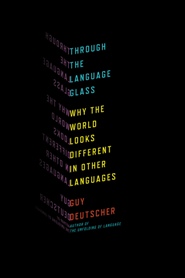
Guy Deutscher approached the subject of his latest book — how language changes the way we think — with caution. “The question of the place of language between nature and nurture has always fascinated me. But it’s a hugely controversial subject, so I was afraid of doing it before,” he explained. But in Through the Language Glass: Why the World Looks Different in Other Languages, he dives into the question of how what we speak transforms the way we think. Below, he explains how languages create our notions of space, our connotations for objects, our interpretation of color, and why many of the answers still remain mysterious.
Q. What assumptions do we make about how language changes the way we think, and why are they so controversial?
 A. It’s hugely controversial because it has rather embarrassing historical baggage attached to it. In the past there was a very popular theory called linguistic relativity, which claimed – without any evidence whatsoever – that the language we speak determines what we’re able to think. It was an extremely popular theory from the 1940s until the 1960s. People were quoting it uncritically in almost all disciplines and making the most ridiculous claims about the alleged power of language to limit what the speakers can understand, and saying that if a certain language has no word for a certain concept, this means its speakers ‘would not be able to understand’ this concept.
A. It’s hugely controversial because it has rather embarrassing historical baggage attached to it. In the past there was a very popular theory called linguistic relativity, which claimed – without any evidence whatsoever – that the language we speak determines what we’re able to think. It was an extremely popular theory from the 1940s until the 1960s. People were quoting it uncritically in almost all disciplines and making the most ridiculous claims about the alleged power of language to limit what the speakers can understand, and saying that if a certain language has no word for a certain concept, this means its speakers ‘would not be able to understand’ this concept.
But after a while it dawned on the academic community that this was mostly hot air – because actually one can express anything in any language, at least with circumlocutions. So the pendulum swung in the other direction, and the subject became almost a taboo. So today if you just mention the words linguistic relativity you risk being put in the category of charlatan. But we’ve now grown up enough to put the trauma of the past behind us and try to look at this question in a grown-up way. Some researchers have done this in the last few years, and they have found that language does actually affect some aspects of our mind, but in quite a different way than was believed in the past.
Q. What have we learned since then about the way language does change us?
A. There has been quite a lot of research in different areas, and a lot is still ongoing. In my book I concentrate on three areas because I think they’re the ones where the examples are most plausible, and the results most convincing. It doesn’t mean the influence of language is limited to those three examples. These three areas are the language of space – not galaxies and planets, but the way we describe the arrangements of objects around us. The second is the gender system of some languages and the third is color – the way languages divide the spectrum into different concepts.
The most dramatic example is the language of space. For us it seems completely natural to talk about the arrangement of space around us in egocentric coordinates. We describe things as being to the left or the right or in front of or behind us, all based on our own bodies. What is in front becomes behind if we turn around. You would naturally imagine that this is the way all languages do it, and that’s what people have believed for centuries.
But it turns out there are languages that do things in a very different way, and don’t use egocentric coordinates at all. Instead they use geographic descriptions for everything. People who speak such languages would tell you that you have “a crumb on your western cheek”. They would say they left something “on the eastern corner of the southern table of the western room of your house”. The way this affects thought beyond merely language is that if you grew up with such a language, you have to pay constant attention – every second of your life from infancy – to your orientation in the cardinal directions. People who grew up with such a language develop a perfect pitch for directions, something like a GPS navigation system in their brains, except it’s even better because it works indoors and in caves.
Q. What finding in this recent research surprised you the most?
A. Probably the effects of spatial language most surprised me. I knew about it when I first began researching for this book, but I didn’t know how dramatically this seems to affect the mind. A different thing that surprised me is in the area of color – the question of how we divide the color spectrum into different concepts. What is most surprising there is that so much of the modern insights about this question in fact merely replicate things that were done in the nineteenth century, and later completely forgotten. We are much less original than we think.
The basic point about color is that what seems natural to us is to a considerable extent just a cultural convention. We may think of green and blue as separate colors, but in many languages, they are treated as just shades of the same color. Conversely, Russian treats as two distinct colors what we call two shades of the same color, light blue and dark blue. There are even languages that divide the whole spectrum into just three color concepts: black, white and red, and all the colors that we differentiate are subsumed into these three categories.
Before I started researching this book, what I knew about color was what I suppose most linguists know, and this was that serious research on this dates back to 1969, when a very famous book by two researchers from Berkeley, Brent Berlin and Paul Kay was published, which made what was then claimed to be entirely new discoveries. Berlin and Kay discovered that languages acquire color words in a predefined order-first come black and white, then red, then after that yellow then green and only after that, blue. What I found out when I started reading works from the nineteenth century was that actually this amazing discovery was made exactly a hundred years before! And the whole question was the subject of intense debate from about 1860s until the First World War. For some reason all of that was completely forgotten – and a lot of our newest allegedly cutting-edge research merely replicates the same conclusions that were reached in the 19th century.
Q. How does speaking more than one language change the way we think?
A. It’s an extremely good question, but like many good questions, it’s also very difficult. The honest answer is that very little research has been done specifically on the interaction of two languages in this way, because even understanding the influence of one particular language on the brain is such a difficult task, and we are in the pioneering stages of this field. Take genders for example. Various psychologists have shown that if your language assigns inanimate objects like apples and tables to a masculine or feminine gender, this can affect the connotations and associations that speakers have about such objects. Now, there have been a few studies on gender systems with bilinguals who grew up with two languages, like French and German, which both assign inanimate objects to a feminine or masculine gender, but quite often these genders clash. I think the results of these studies were rather confused – and it’s not surprising. But if we take an easier case, let’s say you are bilingual from birth in English and Spanish, then I would imagine that because English doesn’t have a gender system, it wouldn’t clash with or undermine the effect of the Spanish genders. So here, the effects of one of your languages (Spanish) would not be contradicted by the other (English). And so I’d expect that in this particular example, bilingual English and Spanish speakers may not be very different from monolingual Spanish speakers, but they will be quite different from monolingual English speakers.
I can add anecdotally about myself – although it’s not such a good example as I grew up monolingual – that although I’ve been speaking mainly English for 20 years, I still have to make an effort not to speak of beds as “shes” and apples and tables as “hes”. It’s imprinted in my mind because the language I grew up into (Hebrew) has these genders. I can suppress it when I speak, but the way I think about all these objects, even when I speak English, is colored with gender associations.
Q. Do the differences between languages make it harder for us to truly assimilate into a language that isn’t our first?
A. It’s well known that it is very difficult to learn a language perfectly unless you assimilated it in childhood. There may not be a definite cut-off point, but the earlier you start, the more likely you’ll be able to achieve a perfect command of the second language. This applies in first instance to pronunciation. But I think the implications of some of the examples I mention in the book are that these effects go much beyond pronunciation or even grammar-it’s also about the types of information that you are trained to pay attention to. It becomes much more difficult to turn habits into second nature if you learn them at a later age, so if you acquire a language in later years, the effects this language may create on your habits of mind may be much less pronounced.
Q. What language do you speak, and how has it shaped the way you see things?
A. This is a question that many linguists dread. I’m not so brilliant at picking up languages quickly, especially not when it comes to speaking them, but I’m very good at forgetting things I already knew. My mother tongue is Hebrew. I speak English reasonably well, at least when I’m not tired. And I speak a few European languages at various stages of rustiness. The languages I’ve done most research on (the ancient languages of Mesopotamia) have not been spoken for around 3000 years – so I have hardly had much opportunity to practice my conversational skills. But unfortunately, many of the languages I know reasonably well are quite similar to one another – being European languages – which doesn’t give me as much perspective on the real scope of variation among human languages.
Q. You mentioned that most European languages are similar to each other – where do the major differences between languages occur?
A. The most dramatic differences occur not between Spanish and English, or French and German, but between ‘us’ and the languages of small simple societies, in places like Australia and Papua and South America and Africa. So it’s only by looking at such languages that we can really discover what is truly natural about all languages, and what merely happens to be the conventions we are used to. And this is why studying these languages before they disappear is so important.
*Photo of the author by Janie Steen, courtesy Henry Holt and Company. Photo of artists’ pencils courtesy Gauri Ma.





Send A Letter To the Editors